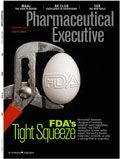Pharma's Identity, From I to T
The FDA process itself is looking more like the unsavory 'sausage factory' associated with drafting partisan legislation
It is often said that pharmaceuticals is at base an information industry. Actually defining what that means holds a clue to the industry's identity. Our editorial offerings this month demonstrate how difficult a task this can be, if one accepts the fact that information is only raw material, not evidence—and evidence is not knowledge unless it can be applied in a way that is both relevant and accessible to those who use it.

William Looney
Pharm Exec's lead feature this month provides an influential outsider's view on how FDA is grappling with a basic contradiction in its central mission: maintaining public confidence about risk versus benefit while coping with criticism of the quality and integrity of the evidence that guides its decisions. Our interview with Harvard University professor Daniel Carpenter exposes the root issue of how to render definitive judgments about drug safety and efficacy in an era where technology is making data more available, with more options to address a broader range of clinical—and policy—questions. This means not only that trial results required for authorization are increasingly open to interpretation but that the FDA process itself is looking more like the unsavory "sausage factory" associated with drafting partisan legislation.
Leveraging evidence to increase uptake of new medicines is also the theme of our second feature, which evaluates the business impact of US government support for comparative effectiveness research (CER). Although the health reform legislation enacted in March bars government-sponsored CER from being applied to pricing, the authors conclude that the distinction between clinical measures and cost is porous; the barrier has already effectively been breached in the private sector.
Again, building consensus with other stakeholders on how to address the fallout from CER ought to be a key industry priority, but the task is complicated as companies can suffer commercially from getting too far out front on this issue. Our Strategy column (page 34) this month by Pfizer's John Swen is illustrative of this reality, suggesting the main target of CER advocates will be specialty drugs, due to their high price tags and the difficulty in establishing value on a prospective basis, particularly in emerging areas of therapy like oncology.
The best advice? Build your approach on CER around three fundamental planks: 1) challenge the specific methodologies used to gauge cost effectiveness, not the legitimacy of the institutions that administer them; 2) demand that industry associations do the heavy lifting—including the role of "bad cop"—in contesting efforts to extend the reach of CER into P&R; and 3) insist that CER evidence be evaluated at a level closest to the patient, as an aid to clinical decision making rather than as an expression of ministerial fiat. In fact, "globalization" of CER may be the most unanticipated side-effect of the big bucks the federal treasury is now devoting to CER—the $1.1 billion allocated to CER by the stimulus bill is more than eight times the annual budget of the UK National Institute for Health and Clinical Excellence (NICE). It is thus likely some of this money will support expansion of CER tools beyond our own shores, to places where cost controls do drive access.
Finally, our annual review of the best in drug promotion—the Rx Club awards—confirms the adage that nothing changes when it comes to using evidence to persuade the consumer. Despite new technology that permits ever more detailed dissections of purchasing preferences, the most effective campaigns still connect in a way that is accessible and relevant to the individual, and presented with that non-quantifiable "human touch" top of mind. In an industry where the obsession is for scored, scalable, and skin-tight metrics driven by reams of data, the ability to sift out what is "core to the pore" remains key to launch success.
William Looney
Editor-in-Chief
Is Artificial Intelligence a ‘Product’? Products Liability Implications for AI-Based Products
April 10th 2025As the physical products we use evolve to become increasingly complex, traditional products liability frameworks may not always fit to provide remedies for harm that can result from using novel product types.
